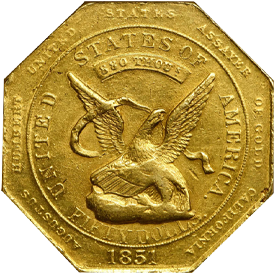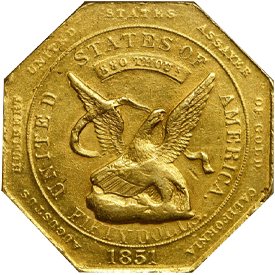In September 1850 Congress authorized the Secretary of the Treasury to contract with a well-established assaying business in California to affix the stamp of the United States to bars and ingots:
The Secretary of the Treasury...be authorized and directed to contract, upon the most reasonable terms, with the proprietors of some well-established works now in successful operation in California, upon satisfactory security, to be judged by the Secretary of the Treasury, who shall, under the supervision of the United States Assayer, to be appointed by the President by and with the advice and consent of the Senate, perform such duties in assaying and fixing the value of gold in grains and lumps, and forming the same into bars, as shall be prescribed by the Secretary of the Treasury; and that the said United States Assayer shall cause the stamp of the United States, indicating the degree of fineness and value, to be affixed to each bar or ingot of gold that may be issued from the establishment; provided that the United States shall not be held responsible for the loss of any gold deposited with said proprietors for assay.
The honor went to Moffat & Co., a firm with an excellent reputation. Augustus Humbert, a New York City maker of watch cases, was appointed to the position of United States Assayer. Moffat & Co. served notice to the public that its private business would cease and further activities would be in connection with Humbert.
At the end of January 1851 Augustus Humbert arrived in San Francisco At the same time the first octagonal $ 50 gold piece bearing his stamp was issued. The Pacific News of February 1,1851 noted that "the dies for this purpose-the striking of the $50 pieces have been procured, and the first coin produced by them was shown us yesterday." Edgar H. Adams expressed the opinion that the dies tor the first two varieties of the octagonal $50 pieces were the work of Charles Cushing Wright, one of America's most famous engravers, who at the time lived in New York City. He believed that Augustus Humbert commissioned Wright to make assayer' s stamps. Humbert probably believed he would be engaged in smelting and assaying raw qold, making ingots from the same, and then impressing the stamp of the United States Assayer on them to certify the gold to be o a
certain weight, fineness and value.
The existence of bronze pattern pieces supports Adams' thought. One piece is signed on the edge by Wright as "Wright fee, for "Wright fecit" (Latin for "Wright made it"). Inscriptions on these patterns as well as the first octagonal ingots produced for circulation simply have the letters D C DWT. GRS. It was intended that the value in dollars and cents and the weight in pennyweights and grains could simply be stamped in the place provided. In this way ingots of $50, $100, $200 or any other desired denomination could be produced, differing from each other only by size, weight, and fineness, but incorporating the same stamp.
On February 14, 1851 San Francisco Prices Current contained an article relating to the $50 slugs, indicating their regular production was about to begin:
The above cut represents the obverse of the United States ingot, or rather, coin, of the value of $50, about to be issued at the Government Assay Office. It is precisely of this size and shape.
The larger ones of $ 1 00 and $ 200 are exactly similar, except they are proportionately thicker. The reverse side bears an impression of rayed work without any inscription. Upon the edges is the following: "Augustus Humbert United States Assayer— California Gold 1851." Those of $500 and $1,000 are in form parallelograms, about five inches in length, and one and three-quarter inches in breadth, and ranging in thickness — the smaller ones about three-tenths of an inch and the larger six-tenths.
The $50 pieces will be of uniform value, and will be manufactured in the same manner as coins — the other may vary according to weight and fineness from the denomination mentioned.
By order of the Secretary of the Treasury these ingots and coin are to be received for duties and other dues to the United States Government, and our bankers, we are advised, will receive them at their stamped value.
This will produce an important change in the monetary affairs here, gold dust will immediately go up, and as a necessary consequence foreign and domestic (European exchange will be at a premium 5 to 7 percent...
The Daily Alta California commented on the new $50 pieces on February 21, 1851:
The new $50 gold piece, manufactured under the Act of Congress appointing a United States Assay Office in California, and made under the supervision of the United States Assayer, was issued by Moffat & Co. yesterday. About 300 of these pieces have already been struck off. The larger ones, of $100 and $200, will be of the same stamp and size, differing only in thickness. Those over $200 will contain the same stamp, but will be struck in the form of bars. These coins are of course a leqal tender and are the coins of the United States Government to all intents and purposes. The coin is peculiar, containing only one face, and the eagle in the center, around which are the words "UNITED STATES OF AMERICA." Just over the eagle is stamped "887 THOUS." signifying the fineness of the gold. At the bottom is stamped "50 DOLLS." The other face is ornamented with a kind of work technically called engine-turning, being a number of radii extending from the common center, in which is stamped, in small figures, "50". Around the edge is stamped the name of the United States Assayer. We trust our reader may learn the character of this new coin by ocular demonstration.
The 10s will have a fineness of 883 thousandths, and will weigh 262-7/10 grains. The 20s will be of the same fineness and will weigh 525-4/10 grains.
No more coin will be manufactured bearing the stamp of Moffat & Co." and that already issued will be redeemed whenever demanded.
Moffat & Co.
Notice: Moffat & Co. will hereafter, independently of their contract with the United States Government, receive gold dust for melting and assaying, and return the same in bullion, at a charge of 1 % on its value. The bars will at all times be ready for delivery within 48 hours.
Prices Current on February 16, 1852, described the new $10 piece of the Assay Office:
The United States Assayer now has the authority from the Government to issue ingots or coin of the denomination of $10 and $20. The obverse of these pieces is in design what is termed "engine turned," with a band across the center bearing this inscription: AUGUSTUS HUMBERT UNITED STATES ASSAYER OF GOLD CAlIFORNIA 1852.
The reverse has an eagle similar to the $50 piece; over the scroll indicative of the fineness of the coin in thousandths — "884 Thous."- under the eagle "Ten Dols. with the legend "United States of America." This is far preferable to the system of private coinage, although certainly not so desirable as a regular mint issue.
On February 28th the same publication contained a notice concerning $20 pieces:
The United States Assay Office commenced this morning issuing the $20 pieces. In our last correspondence we neglected to give the fineness and weight of these, and also the $10 pieces, which is as follows: The fineness of both pieces is 88 thousandths, the weight of the twenty 525.4; of the tens, 262.7 grains.
The San Francisco Herald contained a notice of February 16, 1852 which advised the public that:
The following denominations of coin are now authorized to be issued by the Treasury Department from the Assay Office: $10, $20, and $50; also bars of $500 and $1000.
From February until the autumn of 1 852 very little mention of the Assay Office appeared in the San Francisco periodicals. There were only scattered comments from time to time, including an editorial which stated that the existence of the Assay Office was contrary to the purpose of establishing an official government mint in California, and that the owners of the Assay Office would find their business in jeopardy and would press hard against the establishment of a mint.
The public became confused concerning the fineness of the gold issues being produced by the Assay Office. On October 13, 1852, Augustus Humbert printed an explanation in the San Francisco Herald. He stated that the issues produced were of the fineness .880, .884, and .887 as these figures were about the average fineness of gold found in California. He noted that coins with a lower degree of fineness would have a greater total weight of metal so that they would possess the full intrinsic value equal to coins from the United States Mint.
Humbert went on to say that gold received in more recent times was higher in fineness than earlier deposits, so that it would be possible from that point forward to adhere to the Mint standard of .900 fine, with the remaining alloy being silver as originally found in connection with the gold. The Coinage Act of January 18, 1837 provided that:
The standard for both gold and silver coins of the United States shall hereafter be such as of 1,000 parts by weight 900 shall be pure metal, and 1 00 of alloy; and the alloy of gold com shall be of silver and copper, provided the silver does not exceed one half of the whole alloy.
Humbert pointed out that in order to strictly conform to the Mint standard and have coins with the fineness of .900, and with an alloy of "not more than one half silver, and the balance copper," it would be necessary to separate the silver from the gold and substitute copper in its place. He went on to say:
It is very evident that this long, tedious, and expensive process cannot be adopted until the proper facilities are afforded by the branch of the Mint which is to be established in San Francisco, connected with which there must necessarily be refining and chemical work for the manufacture of acids.
After October 1852 nearly all ingots issued by the Assay Office were .900 fine.
The total production of the United States Assay Office of Gold during the years of its operation is not known. It was estimated during the first quarter of 1851 that $600,000 worth of coin of the $50 denomination were made. Prices Current on September 30, 1851, noted that the Assay Office had been increasingly busy in recent times and occasionally had attained the production of $100,000 in $50 ingots per day. What happened to all of them? Adams notes that certain foreign bankers preferred octagonal ingots to regular American coins, thus leading to the export of huge quantities, some from San Francisco and others from New York City. A newspaper item of January 13, 1853, notes that the steamer Asia from New York to Liverpool carried $200,000 in $50 pieces from California.
On December 14, 1853 the United States Assay Office of Gold ceased operations. Machinery and equipment were transferred to the new San Francisco Mint.










